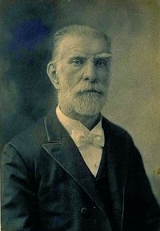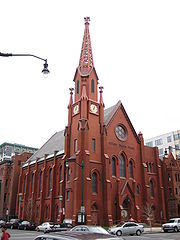
Adolf Cluss
Encyclopedia
Adolf Cluss was a German
-born American
immigrant who became one of the most important architect
s in Washington, D.C.
, in the late 19th century, responsible for the design of numerous schools and other notable public buildings in the capital.
He was born in 1825 in Heilbronn
in the Kingdom of Württemberg
in south-west Germany
. His father was a master builder, and young Cluss set out as an itinerant carpenter when he left Heilbrunn at age nineteen. In his travels, he met and became a friend of Karl Marx
and a supporter of communist
principles at a time of political and revolutionary ferment in Germany. He joined the Communist League
and became a member of the Mainz
Worker Council. The failure of the German revolutionary movement in 1848
led him to leave Germany when he was twenty-three, along with other Forty-Eighters
who emigrated to the United States at that time. In the United States, he continued his political activity into the 1850s, maintaining an extensive correspondence with Marx and Engels
and writing and publishing political articles for the German-American community.
Settling in Washington, D.C., Cluss also began building a highly successful practice as an engineer and architect. In the following decades, from the 1860s to the 1890s, he was responsible for designing scores of major public buildings, including at least eleven schools, as well as markets, government buildings, museums, residences and churches. By 1872, he had become City Engineer and a member of the Board of Public Works, overseeing some of the civic improvements that transformed Washington in the 1870s: street paving, sewer construction, and the planting of thousands of street trees. Cluss's schoolhouse designs were particularly innovative and influential, though only two of his red-brick school masterpieces remain, Franklin School and Sumner School in downtown Washington. The Franklin School was completed in 1869 earning the Washington public school system a Medal for Progress. He designed four major buildings on the National Mall
Cluss's schoolhouse designs were particularly innovative and influential, though only two of his red-brick school masterpieces remain, Franklin School and Sumner School in downtown Washington. The Franklin School was completed in 1869 earning the Washington public school system a Medal for Progress. He designed four major buildings on the National Mall
, including the still-standing Smithsonian
Arts and Industries Building
. He built six houses of worship, including Calvary Baptist Church, located at 777 8th Street, N.W.
Two of the city's major food markets, Center Market and Eastern Market
, were built to his design, the latter surviving and restored to use after a disastrous 2007 fire. His flagship store for Lansburgh's
opened in 1882.
Cluss was also active as a builder of mansions for the Washington elite. In 1880, he was hired to create what became Washington's first apartment building, Portland Flats, an ornate, six-floor, 39-unit creation on the south side of Thomas Circle
. Almost all of Cluss' residential creations have been demolished—Portland Flats, for instance, was torn down in 1962 to make way for an office building.
Red brick was Cluss' favorite building material; that, and his early communist sympathies, led some to dub as the "Red architect" a man who in later life became a confirmed Republican.
A descriptive list of Cluss's known buildings and an interactive map showing their locations can be found here.
Germany
Germany , officially the Federal Republic of Germany , is a federal parliamentary republic in Europe. The country consists of 16 states while the capital and largest city is Berlin. Germany covers an area of 357,021 km2 and has a largely temperate seasonal climate...
-born American
United States
The United States of America is a federal constitutional republic comprising fifty states and a federal district...
immigrant who became one of the most important architect
Architect
An architect is a person trained in the planning, design and oversight of the construction of buildings. To practice architecture means to offer or render services in connection with the design and construction of a building, or group of buildings and the space within the site surrounding the...
s in Washington, D.C.
Washington, D.C.
Washington, D.C., formally the District of Columbia and commonly referred to as Washington, "the District", or simply D.C., is the capital of the United States. On July 16, 1790, the United States Congress approved the creation of a permanent national capital as permitted by the U.S. Constitution....
, in the late 19th century, responsible for the design of numerous schools and other notable public buildings in the capital.
He was born in 1825 in Heilbronn
Heilbronn
Heilbronn is a city in northern Baden-Württemberg, Germany. It is completely surrounded by Heilbronn County and with approximately 123.000 residents, it is the sixth-largest city in the state....
in the Kingdom of Württemberg
Württemberg
Württemberg , formerly known as Wirtemberg or Wurtemberg, is an area and a former state in southwestern Germany, including parts of the regions Swabia and Franconia....
in south-west Germany
Germany
Germany , officially the Federal Republic of Germany , is a federal parliamentary republic in Europe. The country consists of 16 states while the capital and largest city is Berlin. Germany covers an area of 357,021 km2 and has a largely temperate seasonal climate...
. His father was a master builder, and young Cluss set out as an itinerant carpenter when he left Heilbrunn at age nineteen. In his travels, he met and became a friend of Karl Marx
Karl Marx
Karl Heinrich Marx was a German philosopher, economist, sociologist, historian, journalist, and revolutionary socialist. His ideas played a significant role in the development of social science and the socialist political movement...
and a supporter of communist
Communism
Communism is a social, political and economic ideology that aims at the establishment of a classless, moneyless, revolutionary and stateless socialist society structured upon common ownership of the means of production...
principles at a time of political and revolutionary ferment in Germany. He joined the Communist League
Communist League
The Communist League was the first Marxist international organization. It was founded originally as the League of the Just by German workers in Paris in 1834. This was initially a utopian socialist and Christian communist group devoted to the ideas of Gracchus Babeuf...
and became a member of the Mainz
Mainz
Mainz under the Holy Roman Empire, and previously was a Roman fort city which commanded the west bank of the Rhine and formed part of the northernmost frontier of the Roman Empire...
Worker Council. The failure of the German revolutionary movement in 1848
Revolutions of 1848 in the German states
The Revolutions of 1848 in the German states, also called the March Revolution – part of the Revolutions of 1848 that broke out in many countries of Europe – were a series of loosely coordinated protests and rebellions in the states of the German Confederation, including the Austrian Empire...
led him to leave Germany when he was twenty-three, along with other Forty-Eighters
Forty-Eighters
The Forty-Eighters were Europeans who participated in or supported the revolutions of 1848 that swept Europe. In Germany, the Forty-Eighters favored unification of the German people, a more democratic government, and guarantees of human rights...
who emigrated to the United States at that time. In the United States, he continued his political activity into the 1850s, maintaining an extensive correspondence with Marx and Engels
Friedrich Engels
Friedrich Engels was a German industrialist, social scientist, author, political theorist, philosopher, and father of Marxist theory, alongside Karl Marx. In 1845 he published The Condition of the Working Class in England, based on personal observations and research...
and writing and publishing political articles for the German-American community.
Settling in Washington, D.C., Cluss also began building a highly successful practice as an engineer and architect. In the following decades, from the 1860s to the 1890s, he was responsible for designing scores of major public buildings, including at least eleven schools, as well as markets, government buildings, museums, residences and churches. By 1872, he had become City Engineer and a member of the Board of Public Works, overseeing some of the civic improvements that transformed Washington in the 1870s: street paving, sewer construction, and the planting of thousands of street trees.

National Mall
The National Mall is an open-area national park in downtown Washington, D.C., the capital of the United States. The National Mall is a unit of the National Park Service , and is administered by the National Mall and Memorial Parks unit...
, including the still-standing Smithsonian
Smithsonian Institution
The Smithsonian Institution is an educational and research institute and associated museum complex, administered and funded by the government of the United States and by funds from its endowment, contributions, and profits from its retail operations, concessions, licensing activities, and magazines...
Arts and Industries Building
Arts and Industries Building
The Arts and Industries Building is the second oldest of the Smithsonian museums on the National Mall in Washington, D.C. Initially named the National Museum, it was built to provide the Smithsonian with its first proper facility for public display of its growing collections.The building, designed...
. He built six houses of worship, including Calvary Baptist Church, located at 777 8th Street, N.W.
Two of the city's major food markets, Center Market and Eastern Market
Eastern Market, Washington, D.C.
The Eastern Market is a public market in the Capitol Hill neighborhood of Washington, D.C., housed in a 19th century brick building. It is located on 7th Street SE, a few blocks east of the U.S. Capitol between North Carolina Avenue SE and C Street SE. The Eastern Market is on the National...
, were built to his design, the latter surviving and restored to use after a disastrous 2007 fire. His flagship store for Lansburgh's
Lansburgh's
Lansburgh's was a chain of department stores located in the Washington, D.C. area. The clientele were lower- to middle-income consumers.-History:...
opened in 1882.
Cluss was also active as a builder of mansions for the Washington elite. In 1880, he was hired to create what became Washington's first apartment building, Portland Flats, an ornate, six-floor, 39-unit creation on the south side of Thomas Circle
Thomas Circle
Thomas Circle is a traffic circle in Northwest Washington, D.C., United States at the junction of Massachusetts Avenue, Vermont Avenue, 14th Street, and M Street, N.W.The through lanes of Massachusetts Avenue pass under Thomas Circle...
. Almost all of Cluss' residential creations have been demolished—Portland Flats, for instance, was torn down in 1962 to make way for an office building.
Red brick was Cluss' favorite building material; that, and his early communist sympathies, led some to dub as the "Red architect" a man who in later life became a confirmed Republican.
A descriptive list of Cluss's known buildings and an interactive map showing their locations can be found here.
External links
- Adolf Cluss, An International Exhibition Project
- Goethe-Institut in Washington, DC: Notes on Adolf Cluss
- Washington Post: "Red Architect" Adolf Cluss
- "Adolf Cluss (1825-1905), Architect: From Germany to America", Goethe Institute newsletter, June 2009
- http://www.adolf-cluss.org/

